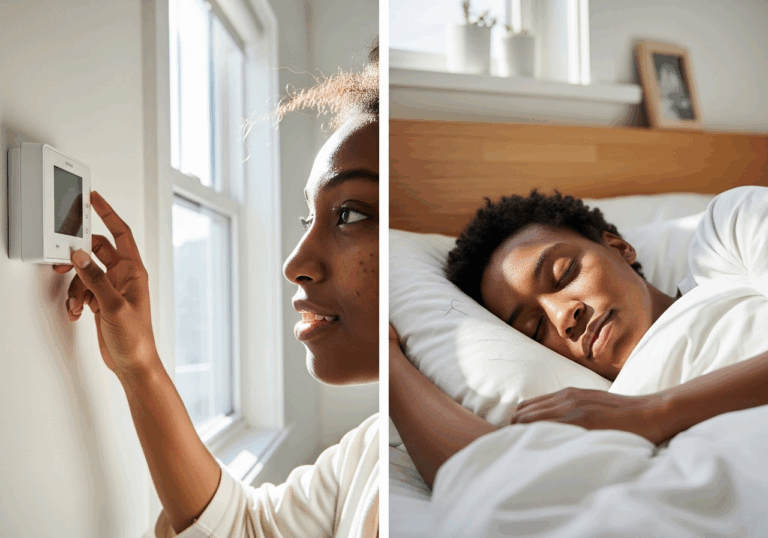Science-Backed Tips
Align Your Sleep for Better Mood Stability
Aligning bedtime within 30 minutes of your circadian midpoint reduces anxiety by ~10%.
📊 Did you know?
💡 Why It Matters
1️⃣
Maintaining bedtime alignment can lead to a 10% decrease in anxiety, improving mental health.
2️⃣
Better sleep timing is linked to enhanced mood stability, which can improve daily functioning.
3️⃣
Consistent sleep patterns can reduce the risk of developing chronic anxiety disorders.
✅ Try These Micro-Tips
🎯
Aim to go to bed within 30 minutes of your natural circadian midpoint each night.
🎯
Track your sleep patterns for at least two weeks to identify your natural bedtime.
🎯
Limit screen time at least 1 hour before your planned bedtime to enhance sleep quality.
🎯
Create a calming bedtime routine to signal your body that it’s time to sleep.
📚 The study
Interestingly, maintaining a consistent sleep schedule that aligns closely with this midpoint can result in approximately a 10% reduction in anxiety and mood disturbances.
This finding underscores the importance of sleep timing and consistency in fostering emotional balance. By prioritizing bedtime alignment, individuals can not only enhance their mood stability but also improve their overall daily functioning.
Moreover, adhering to consistent sleep patterns can significantly lower the risk of developing chronic anxiety disorders, making it a vital aspect of mental health management.
As we navigate our busy lives, it becomes essential to recognize that small adjustments to our sleep habits can yield substantial benefits for our mental well-being.
Embracing a routine that respects our body’s natural rhythms can pave the way for a healthier, more balanced life, ultimately leading to a happier and more productive existence.
So, if you’re looking to boost your mood and reduce anxiety, consider aligning your bedtime within 30 minutes of your natural circadian midpoint.
This simple yet effective change could be the key to unlocking a more stable and fulfilling emotional state.
❓ Frequently Asked Questions ❓
Learn more
How does aligning my bedtime with my circadian midpoint affect my anxiety levels?
Aligning your bedtime within 30 minutes of your natural circadian midpoint can reduce anxiety risk by approximately 10%. This alignment supports emotional balance and improves overall mental health.
What is the significance of the circadian midpoint?
The circadian midpoint is the optimal time for sleep based on your body’s natural rhythms. Going to bed close to this time can enhance sleep quality and mood stability.
How can I determine my natural circadian midpoint?
You can track your sleep patterns for at least two weeks to identify your natural bedtime. This will help you understand when your body naturally feels ready for sleep.
What are the benefits of maintaining consistent sleep patterns?
Consistent sleep patterns can significantly reduce the risk of developing chronic anxiety disorders. They also contribute to better mood stability and daily functioning.
How does screen time before bed affect my sleep quality?
Limiting screen time at least one hour before your planned bedtime can enhance sleep quality. The blue light emitted by screens can interfere with your body’s natural sleep signals.
What can I do to create a calming bedtime routine?
Creating a calming bedtime routine can signal your body that it’s time to sleep. Activities such as reading, meditating, or taking a warm bath can help prepare you for rest.
What is the relationship between sleep timing and mood stability?
Better sleep timing is linked to enhanced mood stability, which can improve your daily functioning. Aligning your bedtime with your circadian rhythm helps maintain emotional balance.
How much can I expect my anxiety to decrease by aligning my bedtime?
Maintaining bedtime alignment can lead to a roughly 10% decrease in anxiety levels. This reduction can significantly enhance your overall mental well-being.
Is it necessary to track my sleep patterns for a long time?
Tracking your sleep patterns for at least two weeks is recommended to accurately identify your natural bedtime. This duration allows for variations in your sleep schedule to be accounted for.
What should I do if I struggle to maintain my bedtime alignment?
If you struggle to maintain your bedtime alignment, consider adjusting your daily routine to prioritize sleep. Implementing a consistent sleep schedule and calming pre-sleep activities can help reinforce this alignment.





